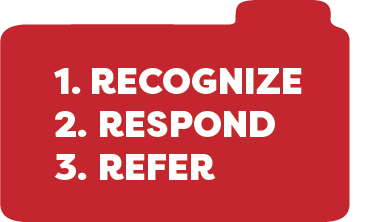Red Folder
Red Folder
The Red Folder initiative is a guide to help faculty, staff and other community members who interact with students to recognize, respond effectively to, and refer distressed students.

Scroll through each of the three steps below.
1. RECOGNIZE
Recognize the signs of distress
Please review the most common signs of distress. Students may also present with indicators not listed.
2. RESPOND
Respond to the signs of distress
Use these important tips to determine the most appropriate response for a distressed student.
“I have missed you in class lately. Is everything okay?”
“You have seemed down the past few classes. Is there anything you want to talk about?”
“It sounds like you are really overwhelmed! Is there anything I can do to help out?”
“I’m hearing you describe that you’ve been really sad.”
“I would like to hear more about how you’ve been feeling.”
“That sounds really challenging.”
“It sounds like you’ve really be struggling. Have you thought about utilizing the counseling center? I have heard great things about it from other students.”
“Thank you for sharing your experience. I am not an expert in this area, but I know someone who might be able to help. Would it be okay if I put you in contact with them?”
3. REFER
Referring a student in distress
Choose from the options below to determine who to contact when you are concerned about a student who is distressed and/or disruptive.
This resource is based on a framework created by our friends at Stonehill College.
Thank you to our colleagues there for allowing us to utilize their resource.